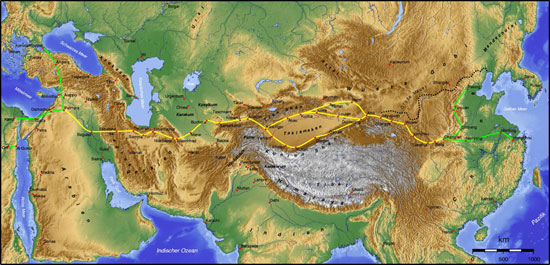Erb Unfolds ~ Page Six
How it happened
Old trade routes do not fade away; they morph into sea routes, train routes, air routes, or major highways.
Silk Road Trading Routes
Large Image, by Kelvin Case, Seidenstrasse_GMT.jpg revision., CC BY-SA 3.0The West had a hot burning desire for Eastern silk. In turn, trading routes were established and the Silk Road touched a majority of 'central' places.
Silk Road primarily refers to the land, but also sea routes, connecting East Asia and Southeast Asia with South Asia, Persia, the Arabian Peninsula, East Africa and Southern Europe.
It was a network of trade routes connecting the East and West, that was central to the economic, cultural, political, and religious interactions between these regions from the 2nd century BCE to the 18th century.
It is worthwhile knowing because of Silk Road trading, the shaman, John the Baptist; a Jewish, itinerant preacher, and his chela, Jesus, were well aware of eastern philosophy and Vedas; including the Rig Veda, Yajur Veda, Sama Veda, and Atharva Veda that were orally transmitted since the 2nd millennium BCE with the help of elaborate mnemonic techniques, which are surprisingly similar to things mentioned in the New Testament, and established a long time before major information was, as usual, destroyed by zealots.
Addendum
Keith Lampe, Ro-Non-So-Te, Ponderosa Pine, with Doug Adamz on Tibetan Bell, created a Western mnemonic called Vocal Energy Health.
With VEH (Vocal Energy Health), after a few sessions of imitating these sounds, one can start doing them alone or--even better--with others; creating an effective practice that requires no gear.
Previous page ~ Index ~ Next Page

